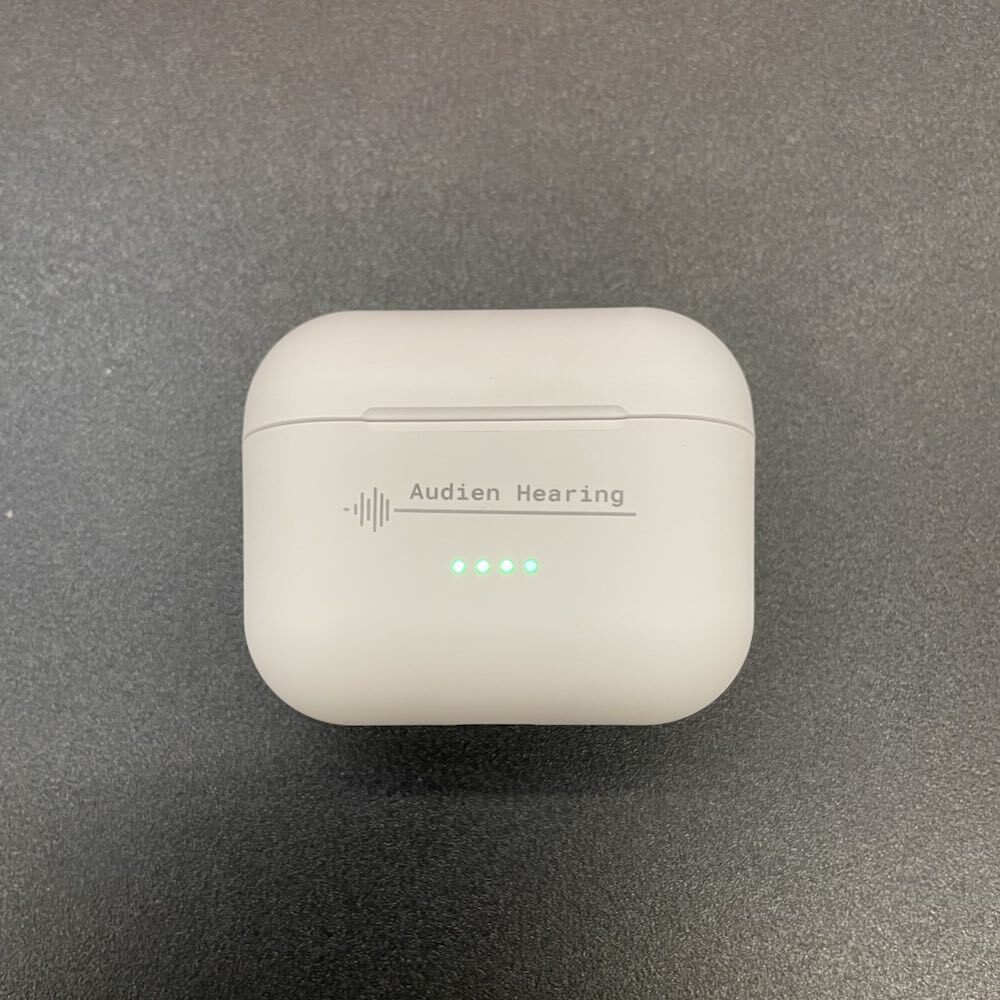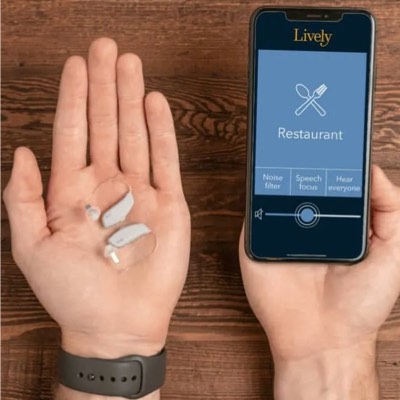Hearing Aid Technology: The Latest Innovations
Updated:
Retirement Living takes an unbiased approach to our reviews. We may earn money when you click a partner link. Learn More

With any piece of technology, advancements are part of the process. For hearing aid technology, these advancements have included changes in size and appearance, alongside more advanced feature additions like rechargeable batteries. Understanding the changes in hearing aid technology allows you to make an informed choice about what features you want or need for your device. Below, we outline some basic technology as well as more advanced features for you to consider.
Basic Hearing Aid Technology
One of the biggest strides in hearing aid technology has been in making the aids themselves much smaller and more discreet. However, there have also been some additional improvements in the performance of the device and the features available.
Sound Synchrony (Ear-to-Ear Connection)
Older hearing aids functioned as monaural devices, meaning they worked independently and needed to be adjusted independently as well. With ear-to-ear connection, also called binaural capability, the hearing aids are connected by a wireless signal. This means that if you adjust one hearing aid, the desired change also takes effect on the other hearing aid.
Additionally, instead of being bombarded with different sounds coming into each ear depending on whom you are talking to and how you are positioned, hearing aids with ear-to-ear connections create one overall sound that more closely resembles natural hearing.
Clearer Phone Calls (Telecoil)
A telecoil is a small copper wire inside the hearing aid which acts similarly to an antenna. The coil finds electromagnetic waves and converts them into an audio signal within the device. The telecoil technology bypasses the hearing aid’s microphone, which helps decrease the background noise transmitted to you. This can become especially prevalent when holding something close to your ear, such as a phone.
Telecoil technology is also important for people who frequent “loop” settings, such as churches, offices, and other crowded rooms, because the technology helps filter unwanted noise.
Less Background Noise (Noise Reduction)
The majority of modern hearing aids feature at least some level of noise reduction. Most noise reduction is done through modulation, which can identify and filter different audio signals picked up from speech and other noises. This means that aids can filter out surrounding loud noises while not blocking out speech.
However, the level of noise reduction and the effectiveness of sound modulation varies by manufacturer, depending on the type of sound management systems they use.
Avoid Painful Electronic Noise (Feedback Management)
In addition to noise reduction, most modern hearing aids also have feedback management systems. Feedback, often heard to you as a hum or high screech, occurs when a sound is amplified through the receiver of the hearing aid and then duplicated through the microphone. Ear wax and even the fit of your hearing aid can result in feedback. Luckily, hearing aids now have ways to reduce the level of feedback or even stop it altogether.
Hear Where You Need It Most (Directional Microphones)
Directional microphones are an essential aspect of a hearing aid’s effectiveness, as they allow the aid to pick up sound from an assigned direction. This makes it easier for you to hear a conversation in a crowded place, for example. But, not all directional microphones are the same.
- Directional Microphones: Pick up sound from an assigned direction. This is typically whatever direction the user is facing, as that is where the majority of conversations will come from. Directional microphones often are paired with omnidirectional microphones as well, which can be adjusted with a switch.
- Omnidirectional Microphones: This type of microphone picks up sounds from all directions. For this reason, it works best in a quiet or indoor setting such as when you are at home.
- Adaptive Directional Microphones: This type of microphone, one of the more recent developments in hearing aid technology, picks up sound from one direction, but can automatically switch over to another direction based on the speech and sound signals that it is receiving.
Advanced Hearing Aid Technology
In addition to the aforementioned standard features, you may want to consider other advanced features that can improve your experience. Whether these features are available often depends on the manufacturer and may affect the cost of the hearing aid considerably.
Less Ringing in Your Ears (Tinnitus Masking)
Ringing in your ears, or tinnitus, is a frustrating issue for many. While a hearing aid cannot treat tinnitus, some models can effectively mask the issue. Hearing aids do this by raising the level of ambient noise until it matches the tinnitus, which allows the brain to focus on the ambient noise rather than on the tinnitus.
Rechargeable Batteries

Several manufacturers have developed rechargeable hearing aids. Here, the devices are placed in a charging pod for approximately 30 minutes to hold a six-hour charge and for three hours to hold a 24-hour charge. Consumers never need to worry again about running out of battery or not having the hand dexterity to change a small hearing aid battery.
Many hearing aids are rechargeable, including the latest hearing aids from Audien seen above.
Connect to What You Want (Bluetooth Capabilities/Wireless Technology)
Wireless connectivity impacts many facets of our daily lives, including the hearing aid market. Many manufacturers have added Bluetooth capabilities to their hearing aids, allowing users to immediately become more connected to and aware of their environment.
Smart devices in your home, such as doorbells, smoke alarms, lighting, safety equipment, and appliances, can all send a signal directly to your hearing aids. You might consider this feature if you enjoy entertainment. For example, you connect your hearing aids to smartphones, tablets, televisions, and computers when you stream music, television programs, and movies, essentially turning them into a pair of earphones.
Hear What’s Important (Environmental Settings/Channels)

With environmental settings, your hearing aid can adapt to different types of noises in a setting to provide you with the clearest possible sound. For example, environmental settings can adjust to the background noise at crowded parties or low sounds, like running water, and filter those sounds to help you hear and converse more effectively.
Many modern hearing aids have pre-programmed settings, such as for the car to combat road noise. In most cases, you can either manually switch into these settings, sometimes called channels, but some models will recognize outside sounds and adjust automatically.
Adjust and Amplify (Smartphone Apps)
Two categories of apps also exist to connect consumers’ hearing aids with their smartphones or tablets.
- Hearing Aid Amplifier Apps: These apps perform exactly as described: they use the built-in microphone in hearing aids to amplify the outside sounds around the consumer. Some can also help to equalize sound between ears and decrease background noise while bringing certain sounds to the forefront. Most popular amplifier apps are free and available for iPhone or Android, including HearYouNow, BioAid, and Hearing Aid with Replay.
- Hearing Aid Controller Apps: These apps allow consumers to control and adjust their hearing aids directly from a smartphone. The most popular control apps are created by a few of the major manufacturers of hearing aids and are compatible with either iPhone or Android devices. These apps include ReSound Smart and ReSound Control from ReSound, TruLink from Starkey, and RemoteControl from Phonak.
Artificial Intelligence in Hearing Aids (Deep Neural Networks)
AI-powered hearing aids that use deep neural networks (DNNs) use smart technology to quickly learn your settings to adjust your hearing automatically. This is helpful in hearing aids because it can be applied to millions of different types of sounds.
DNNs are advanced versions of environmental settings technology discussed above. What a crowded party sounds like to you will be different for someone else. DDN hearing aids learn the sounds most common in your environments and rituals to help your brain interpret sounds quickly and more clearly. This is beneficial for many types of hearing loss.
Waterproof/Water-Resistant Devices
While a waterproof hearing aid sounds like an incredible tool, there are no completely waterproof aids on the market. Instead, there are water-resistant hearing aids that vary in their effectiveness—some can sit in water for several hours, while others may become damaged after just a few minutes.
If water resistance is an important feature, look at the aid’s IP rating, a two-digit number representing the international standard that shows how much outside contaminants—such as moisture—affect your hearing aid. The higher the number, the more protection against water immersion the device will have.
Choosing Hearing Aid Features
Ultimately, what features you end up with will depend on your chosen manufacturer, the cost you are willing to spend, and the features you deem the most essential to your daily life. Our guide to the best hearing aid companies includes hearing devices with varying levels of technology and can help jumpstart your search.